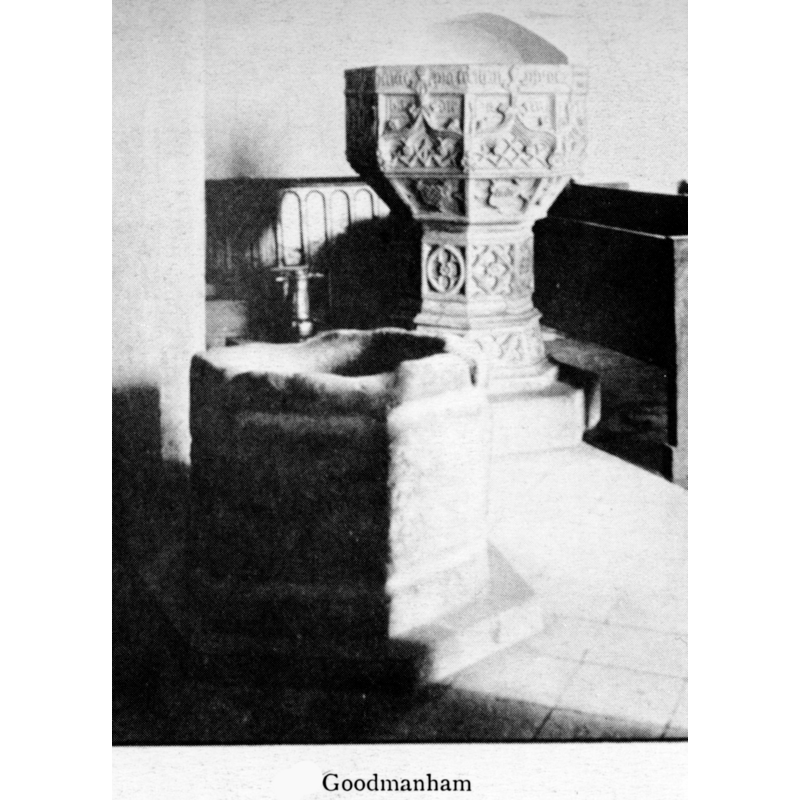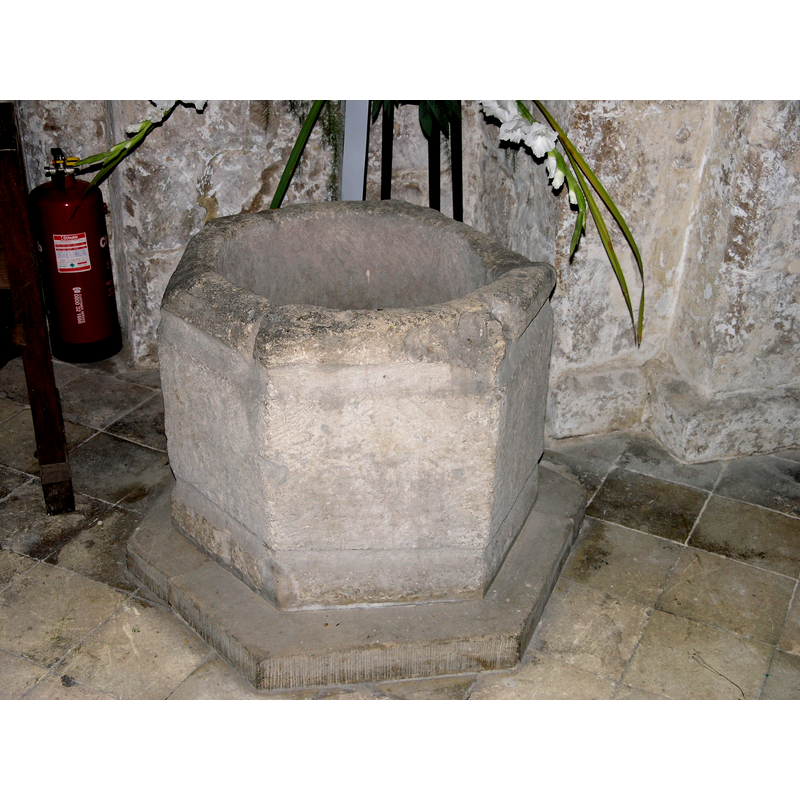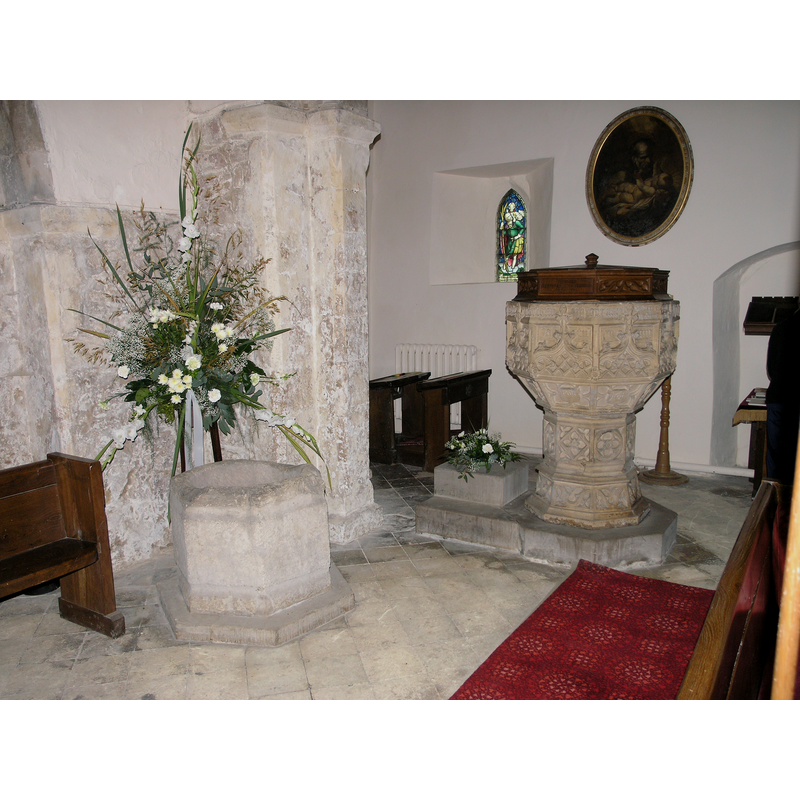Goodmanham No. 2 / Godmanham / Godmundingaham / Godmundin Gaham / Godmondingaham / Gudmundham

Image copyright © Colin Hinson, 2008
Standing permission
Results: 5 records
view of basin - interior
view of font
view of font
view of font - upper view
INFORMATION
FontID: 05284GOO
Object Type: Baptismal Font1
Church/Chapel: Parish Church of All Hallows / All Saints
Church Patron Saints: All Saints
Church Location: Wateringdyke Lane, Goodmanham, East Riding of Yorkshire YO43 3HG
Country Name: England
Location: East Riding of Yorkshire, Yorkshire and the Humber
Directions to Site: Located just NE of Market Weighton, 30 km E of York
Ecclesiastic Region: Diocese of York
Historical Region: Hundred of Weighton
Font Location in Church: Inside the church, next to the 16th-century font
Century and Period: 11th - 12th century?, Pre-Conquest? / Norman?
Credit and Acknowledgements: We are grateful to Colin Hinson, of www.yorkshireCDbooks.com, for his photographs of this font.
Font Notes:
Click to view
Stukeley's Itinerarium Curiosum of 1724 claimed that this is the font in which Paulinus baptised the pagan priest Coifi [spelling varies] and king Edwin. Storer (1815- ) reports on Stukeley's claim "that the identical font in which Paulinus baptised Caefi is still extant in the present church", but suggests that the font is not old enough: "can have no pretentions to great antiquity" and that "the inscriptions sufficiently prove it not to be Saxon work". Unfortunately Storer is descrbing the 16th-century font, which hardly helps the issue. The Gentleman's Magazine (issue of July 1853) identifies the right font and is much less forgiving of the old claim or his maker: "in one corner of the church is a very rudely formed early Norman font, which the sanguine antiquary, Dr. Stukeley, believed to be the identical font in which king Edwin was baptised, forgetting that that ceremony was performed not at Godmanham but in York." Moule (1837) writes: "A font which had previously stood in the church now remains in the garden of the parsonage house at Hotham." Sheahan & Whellan (1857) write: ''There are two fonts in this church, one of very ancient rude workmanship, and the other, which is of the 16th century, is very large, handsome and elaborate. The first mentioned font is a hexagonal stone, of about 1 1/2 foot in height, and a little less to the sides, with a round bowl and drain, perfectly plain except a little grooving round the top and bottom [fn: ''This old font was either given away, or purchased by some farmer in the parish, when the other font was introduced, in whose farm yard it remained for many generations, till 1805, when it was purchased by the Rev. Stillingfleet, and removed to the garden of the parsonage at Hotham, but afterwards restored to the church. Dr. Stukely, the antiquarian, averred that it was even in this font that Paulinus baptised Coifi. It is really wonderful how a man so learned should have so gravely written such a fabulous statement, in the face of the clear testimony of Bede. Stukely says, 'The Apostle Paulinus built the parish church of Goodmanham, where is the font in which he baptised the heathen priest Coifi;' Bede remarks ''Paulinus baptised in the river Swale, because as yet oratories, or fonts, could not be made, in the infancy of the church, in these parts.'' Similarly reported in Bulmer's Directory of 1892. Described and illustrated in Bond (1908) as an unmounted hexagonal font of the Norman period/style; it appears to have suffered considerable damage to its upper rim but survived "by the pious care of the vicar, the archaic font has been deposited safely within the church." ["O si sic omnes", wishfully added Bond (ibid.) expressing his dismay at the abandonment and destruction of many of the early fonts!]. Described as "quite rude" in Glynne's notes of January 1863 (2007). Noted in Hobson (1924) as Perpendicular [did Hobson refer to the other font?]. Pevsner & Neave (1995) inform that this "small hexagonal font, possibly Norman, was rescued from a farmyard in the early C19. Plain except for grooves around the top and bottom." A citation in Bulmer's Directory of 1892 to a Dr. Stukeley's writing in Archaeologia, vol. 1 (1770) refers that "Paulinus built Godmundham church [...] where the original font is, in which he baptized the heathen hight priest, Coifi"; this same source mentions an earlier description in the ANTIQUARIAN ITINERARY [full reference not available] "at variance with Dr. Stukeley's, and we think upon reasonable grounds". [NB: whatever font Stukely was referring to, it would not have been either of the fonts here noted for this site]. [cf. Index entry for Goodmanham No. 1 for the main font in this church]. In Torrens Alzu (2009).
COORDINATES
Church Latitude & Longitude Decimal: 53.8769, -0.6479
Church Latitude & Longitude DMS: 53° 52′ 37.93″ N, 0° 38′ 54.51″ W
MEDIUM AND MEASUREMENTS
Material: stone
Number of Pieces: one
Font Shape: hexagonal
Basin Interior Shape: round
Basin Exterior Shape: hexagonal
Basin Total Height: 45 cm*
Notes on Measurements: * [in Sheahan & Whellan (1857)]
REFERENCES
Betjeman, John, An American's Guide to English Parish Churches (including the Isle of Man), New York: McDowell, Obolensky, 1958
Bond, Francis, Fonts and Font Covers, London: Waterstone, 1985 c1908
Bulmer, T., History and Directory of East Yorkshire, 1892
Glynne, Stephen Richard, The Yorkshire notes of Sir Stephen Glynne (1825-1874), Woodbridge: The Boydell Press; Yorkshire Archaeological Society, 2007
Hobson, Bernard, The East Riding of Yorkshire (with York), Cambridge: At the University Press, 1924
Moule, Thomas, The English counties delineated; or, A topographical description of England [...], London: George Virtue, 1837 [vol. 2]
Pevsner, Nikolaus, Yorkshire: York and the East Riding, London: Penguin, 1995
Sheahan, James Joseph, History and topography of the city of York; the East Riding of Yorkshire and a portion of the West Riding […], Beverley: printed for the publishers by John Green, Market Place, 1857
Storer, James Sargant, The Antiquarian Itinerary, comprising specimens of architecture, monastic, castellated, and domestic. With other vestiges of antiquity in Great Britain, accompanied with descriptions, London: Published for the proprietors by W. Clarke, 1815-1818
Stukeley, William, "The sanctuary at Westminster", I, Archaeologia, 1770, pp. 39-44; p. 43-44
Stukeley, William, Itinerarium Curiosum, or, an Account of the Antiquitys and Remakable Curiositys in Nature or Art observed in travels through Great Britain, London: [Privately printed], 1724
Torrens Alzu, Miguel A., "La pila bautismal de Goodmanham y la evidencia histórica del Venerable", 8 (Junio 2009), Románico: revista de arte de Amigos del Románico, 2009, pp. 50-55; 50-55



